Primary Stability of Orthodontic Titanium Miniscrews due to Cortical Bone Density and Re-Insertion
Abstract
1. Introduction
2. Materials and Methods
2.1. Materials
2.2. Sample Preparation
2.3. Torque Test
2.4. Horizontal Resistance
2.5. Micromotion
2.6. Morphological Evaluation
2.7. Evaluation of Re-Inserted Miniscrews
2.8. Statistical Analysis
3. Results
3.1. Torque Test
3.2. Horizontal Resistance
3.3. Micromotion Test
3.4. Morphological Evaluation
4. Discussion
5. Conclusions
Author Contributions
Funding
Conflicts of Interest
References
- Bourassa, C.; Hosein, Y.K.; Pollmann, S.I.; Galil, K.; Bohay, R.N.; Holdsworth, D.W.; Tassi, A. In-vitro comparison of different palatal sites for orthodontic miniscrew insertion: Effect of bone quality and quantity on primary stability. Am. J. Orthod. Dentofac. Orthop. 2018, 154, 809–819. [Google Scholar] [CrossRef] [PubMed]
- Park, H.-S.; Jeong, S.-H.; Kwon, O.-W. Factors affecting the clinical success of screw implants used as orthodontic anchorage. Am. J. Orthod. Dentofac. Orthop. 2006, 130, 18–25. [Google Scholar] [CrossRef] [PubMed]
- Motoyoshi, M.; Hirabayashi, M.; Uemura, M.; Shimizu, N. Recommended placement torque when tightening an orthodontic mini-implant. Clin. Oral Implant. Res. 2006, 17, 109–114. [Google Scholar] [CrossRef] [PubMed]
- Choi, S.-H.; Hwang, C.-J. Factors Affecting the Failure of TADs and Efforts to Improve the Biomechanical Stability of TADs. In Temporary Anchorage Devices in Clinical Orthodontics; John Wiley & Sons: Hoboken, NJ, USA, 2020; pp. 61–67. [Google Scholar]
- Migliorati, M.; Benedicenti, S.; Signori, A.; Drago, S.; Barberis, F.; Tournier, H.; Silvestrini-Biavati, A. Miniscrew design and bone characteristics: An experimental study of primary stability. Am. J. Orthod. Dentofac. Orthop. 2012, 142, 228–234. [Google Scholar] [CrossRef]
- Chung, C.J.; Jung, K.-Y.; Choi, Y.J.; Kim, K.-H. Biomechanical characteristics and reinsertion guidelines for retrieved orthodontic miniscrews. Angle Orthod. 2014, 84, 878–884. [Google Scholar] [CrossRef]
- Yun, S.-D.; Choi, S.-H.; Cha, J.-Y.; Yu, H.-S.; Kim, K.-M.; Kim, J.; Hwang, C.-J. Effects of recycling on the biomechanical characteristics of retrieved orthodontic miniscrews. Korean J. Orthod. 2017, 47, 238–247. [Google Scholar] [CrossRef]
- Hergel, C.A.; Acar, Y.B.; Ates, M.; Kucukkeles, N. In-vitro evaluation of the effects of insertion and sterilization procedures on the mechanical and surface characteristics of mini screws. Eur. Oral Res. 2019, 53, 25–31. [Google Scholar] [CrossRef]
- Eliades, T.; Zinelis, S.; Papadopoulos, M.A.; Eliades, G. Characterization of retrieved orthodontic miniscrew implants. Am. J. Orthod. Dentofac. Orthop. 2009, 135, 10.e1–10.e7. [Google Scholar] [CrossRef]
- Hung, E.; Oliver, D.; Kim, K.B.; Kyung, H.-M.; Buschang, P.H. Effects of Pilot Hole Size and Bone Density on Miniscrew Implants’ Stability. Clin. Implant. Dent. Relat. Res. 2012, 14, 454–460. [Google Scholar] [CrossRef]
- Tepedino, M.; Masedu, F.; Chimenti, C. Comparative evaluation of insertion torque and mechanical stability for self-tapping and self-drilling orthodontic miniscrews - an in vitro study. Head Face Med. 2017, 13, 10. [Google Scholar] [CrossRef]
- Marquezan, M.; Lima, I.; Lopes, R.T.; Sant’Anna, E.F.; de Souza, M.M.G. Is trabecular bone related to primary stability of miniscrews? Angle Orthod. 2014, 84, 500–507. [Google Scholar] [CrossRef] [PubMed]
- Lee, J.; Pyo, S.-W.; Cho, H.; An, J.-S.; Lee, J.H.; Koo, K.-T.; Lee, Y.-M. Comparison of implant stability measurements between a resonance frequency analysis device and a modified damping capacity analysis device: An in vitro study. J. Periodontal Implant. Sci. 2020, 50, 56–66. [Google Scholar] [CrossRef] [PubMed]
- Choi, S.-H.; Cha, J.-Y.; Joo, U.-H.; Hwang, C.-J. Surface changes of anodic oxidized orthodontic titanium miniscrew. Angle Orthod. 2012, 82, 522–528. [Google Scholar] [CrossRef] [PubMed]
- Kang, S.-Y.; Yu, J.-M.; Kim, H.-S.; Lee, J.-S.; Yeon, C.-M.; Park, K.-S.; Choi, S.-H.; Lee, S.-Y. Influence of Orthodontic Anchor Screw Anchorage Method on the Stability of Artificial Bone: An In Vitro Study. Materials 2020, 13, 3205. [Google Scholar] [CrossRef] [PubMed]
- Devlin, H.; Horner, K.; Ledgerton, D. A comparison of maxillary and mandibular bone mineral densities. J. Prosthet. Dent. 1998, 79, 323–327. [Google Scholar] [CrossRef]
- Kido, H.; E Schulz, E.; Kumar, A.; Lozada, J.; Saha, S. Implant diameter and bone density: Effect on initial stability and pull-out resistance. J. Oral Implant. 1997, 23, 163–169. [Google Scholar]
- Moon, S.H.; Park, S.H.; Lim, W.H.; Chun, Y.-S. Palatal Bone Density in Adult Subjects: Implications for Mini-Implant Placement. Angle Orthod. 2010, 80, 137–144. [Google Scholar] [CrossRef]
- McManus, M.M.; Qian, F.; Grosland, N.M.; Marshall, S.D.; Southard, T. Effect of miniscrew placement torque on resistance to miniscrew movement under load. Am. J. Orthod. Dentofac. Orthop. 2011, 140, e93–e98. [Google Scholar] [CrossRef]
- Migliorati, M.; Drago, S.; Barberis, F.; Schiavetti, I.; Dalessandri, D.; Benedicenti, S.; Biavati, A.S. Torque Loss After Miniscrew Placement: An In-Vitro Study Followed by a Clinical Trial. Open Dent. J. 2016, 10, 251–260. [Google Scholar] [CrossRef][Green Version]
- Migliorati, M.; Drago, S.; Dalessandri, D.; Lagazzo, A.; Gallo, F.; Capurro, M.; Silvestrini-Biavati, A. On the stability efficiency of anchorage self-tapping screws: Ex vivo experiments on miniscrew implants used in orthodontics. J. Mech. Behav. Biomed. Mater. 2018, 81, 46–51. [Google Scholar] [CrossRef]
- ASTM, F. 01: Standard Specification for Rigid Polyurethane Foam for Use as a Standard Material for Testing Orthopedic Devices and Instruments; ASTM: West Conshohcken, PA, USA, 1839.
- Cha, J.-Y.; Kil, J.-K.; Yoon, T.-M.; Hwang, C.-J. Miniscrew stability evaluated with computerized tomography scanning. Am. J. Orthod. Dentofac. Orthop. 2010, 137, 73–79. [Google Scholar] [CrossRef] [PubMed]
- Marquezan, M.; De Souza, M.M.G.; Araújo, M.T.D.S.; Nojima, L.I.; Nojima, M.D.C.G. Is miniscrew primary stability influenced by bone density? Braz. Oral Res. 2011, 25, 427–432. [Google Scholar] [CrossRef] [PubMed]
- Huja, S.S.; Litsky, A.S.; Beck, F.M.; Johnson, K.A.; Larsen, P.E. Pull-out strength of monocortical screws placed in the maxillae and mandibles of dogs. Am. J. Orthod. Dentofac. Orthop. 2005, 127, 307–313. [Google Scholar] [CrossRef] [PubMed]
- Friberg, B.; Sennerby, L.; Roos, J.; Lekholm, U. Identification of bone quality in conjunction with insertion of titanium implants. A pilot study in jaw autopsy specimens. Clin. Oral Implant. Res. 1995, 6, 213–219. [Google Scholar] [CrossRef] [PubMed]
- Huja, S.S.; Katona, T.R.; Burr, D.B.; Garetto, L.P.; Roberts, W.E. Microdamage adjacent to endosseous implants. Bone 1999, 25, 217–222. [Google Scholar] [CrossRef]
- Martin, R.B. Fatigue Microdamage as an Essential Element of Bone Mechanics and Biology. Calcif. Tissue Int. 2003, 73, 101–107. [Google Scholar] [CrossRef]
- Song, Y.-Y.; Cha, J.-Y.; Hwang, C.-J. Mechanical Characteristics of Various Orthodontic Mini-screws in Relation to Artificial Cortical Bone Thickness. Angle Orthod. 2007, 77, 979–985. [Google Scholar] [CrossRef]
- Dalstra, M.; Cattaneo, P.; Melsen, B.J.O. Load transfer of miniscrews for orthodontic anchorage. Orthod. 1 2004, 1, 53–62. [Google Scholar]
- Gallas-Torreira, M.; Abeleira, M.T.; Fernández, J.R.; Burguera, M. Three-dimensional numerical simulation of dental implants as orthodontic anchorage. Eur. J. Orthod. 2005, 27, 12–16. [Google Scholar] [CrossRef]
- Gracco, A.L.T.; Cirignaco, A.; Cozzani, M.; Boccaccio, A.; Pappalettere, C.; Vitale, G. Numerical/experimental analysis of the stress field around miniscrews for orthodontic anchorage. Eur. J. Orthod. 2009, 31, 12–20. [Google Scholar] [CrossRef]
- Singh, S.; Mogra, S.; Shetty, V.S.; Shetty, S.; Philip, P. Three-dimensional finite element analysis of strength, stability, and stress distribution in orthodontic anchorage: A conical, self-drilling miniscrew implant system. Am. J. Orthod. Dentofac. Orthop. 2012, 141, 327–336. [Google Scholar] [CrossRef] [PubMed]
- Choi, S.-H.; Jang, S.-H.; Cha, J.-Y.; Hwang, C.-J. Evaluation of the surface characteristics of anodic oxidized miniscrews and their impact on biomechanical stability: An experimental study in beagle dogs. Am. J. Orthod. Dentofac. Orthop. 2016, 149, 31–38. [Google Scholar] [CrossRef] [PubMed]
- Noorollahian, S.; Alavi, S.; Monirifard, M. A processing method for orthodontic mini-screws reuse. Dent. Res. J. 2012, 9, 447–451. [Google Scholar]
- Mattos, C.T.; Ruellas, A.C.D.O.; Elias, C.N. Is it possible to re-use mini-implants for orthodontic anchorage? Results of an in vitro study. Mater. Res. 2010, 13, 521–525. [Google Scholar] [CrossRef][Green Version]
- Migliorati, M.; Benedicenti, S.; Signori, A.; Drago, S.; Cirillo, P.; Barberis, F.; Biavati, A.S. Thread shape factor: Evaluation of three different orthodontic miniscrews stability. Eur. J. Orthod. 2013, 35, 401–405. [Google Scholar] [CrossRef][Green Version]
- Trisi, P.; Perfetti, G.; Baldoni, E.; Berardi, D.; Colagiovanni, M.; Scogna, G. Implant micromotion is related to peak insertion torque and bone density. Clin. Oral Implant. Res. 2009, 20, 467–471. [Google Scholar] [CrossRef]
- Ren, C.; McGrath, C.; Gu, M.; Jin, L.; Zhang, C.; Sum, F.H.K.M.H.; Wong, K.W.F.; Chau, A.C.M.; Yang, Y. Low-level laser-aided orthodontic treatment of periodontally compromised patients: A randomised controlled trial. Lasers Med. Sci. 2020, 35, 729–739. [Google Scholar] [CrossRef]
- Shuai, C.; Liu, G.; Yang, Y.; Qi, F.; Peng, S.; Yang, W.; He, C.; Wang, G.; Qian, G. A strawberry-like Ag-decorated barium titanate enhances piezoelectric and antibacterial activities of polymer scaffold. Nano Energy 2020, 74, 104825. [Google Scholar] [CrossRef]
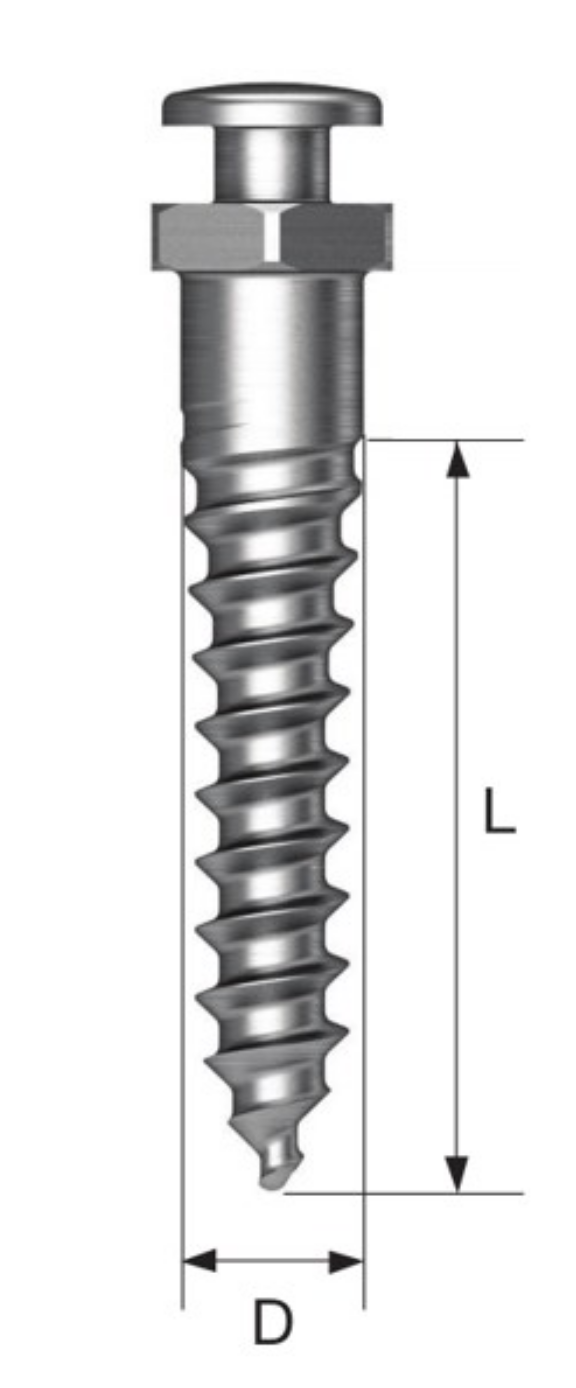
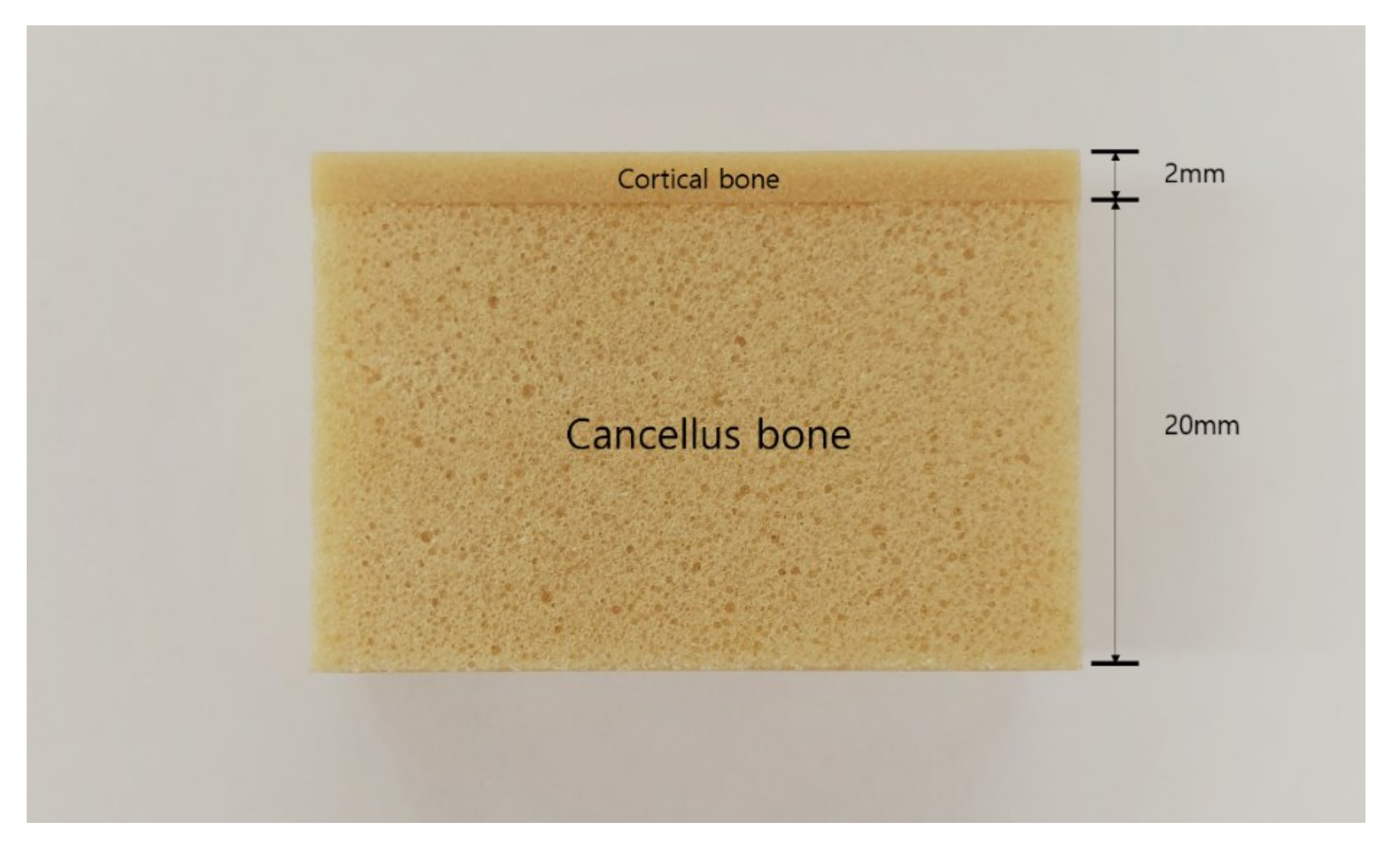
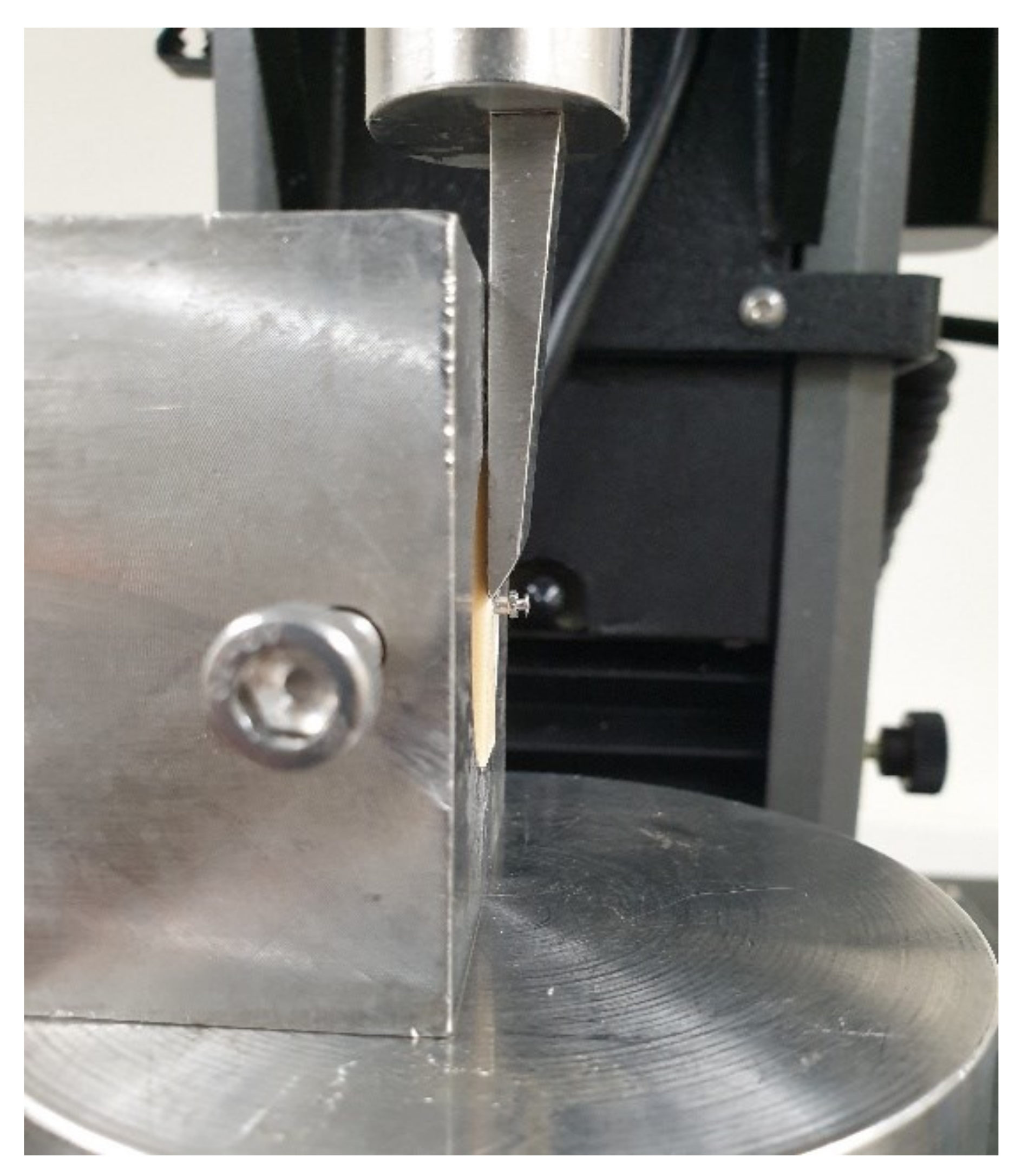
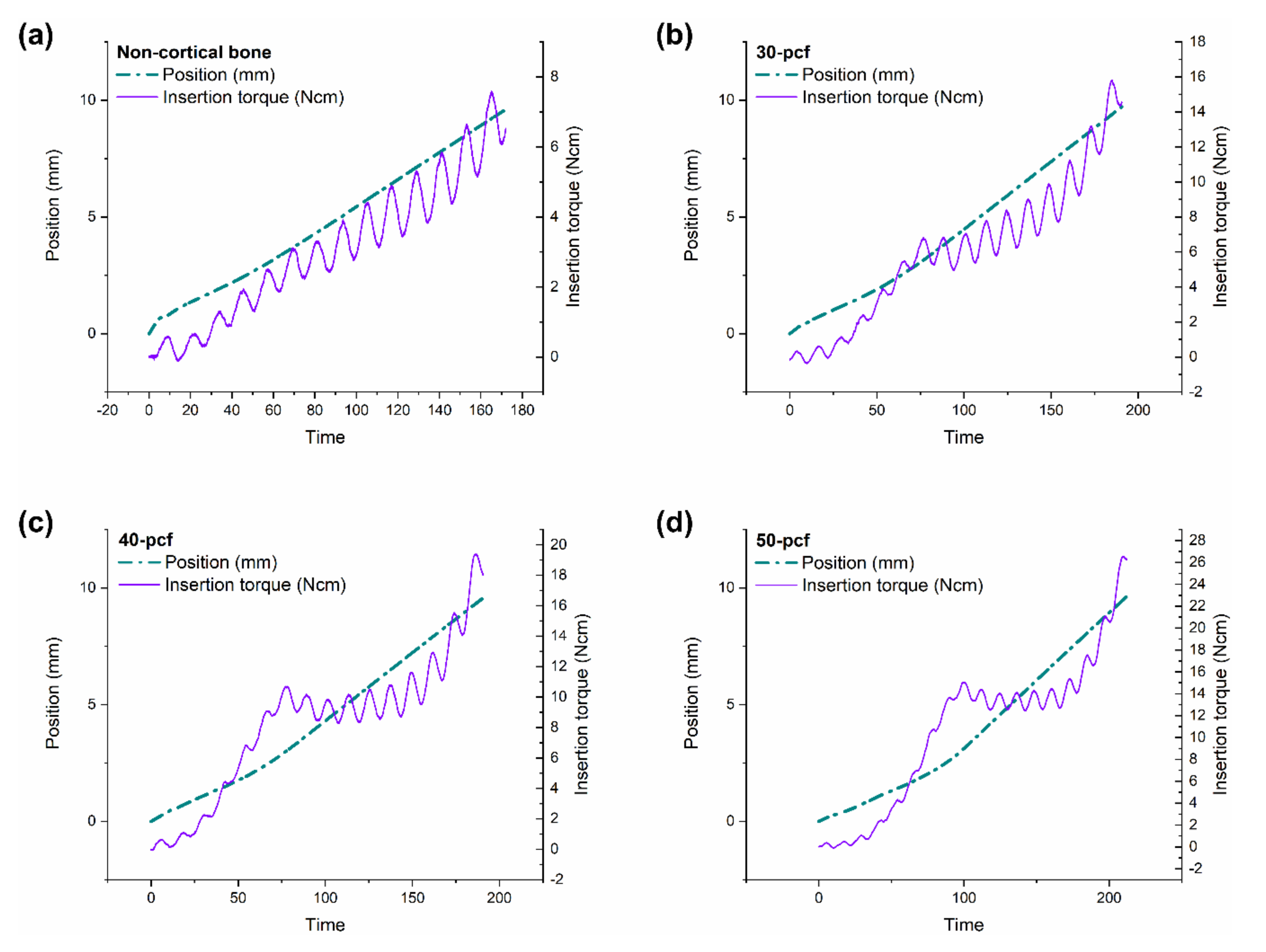
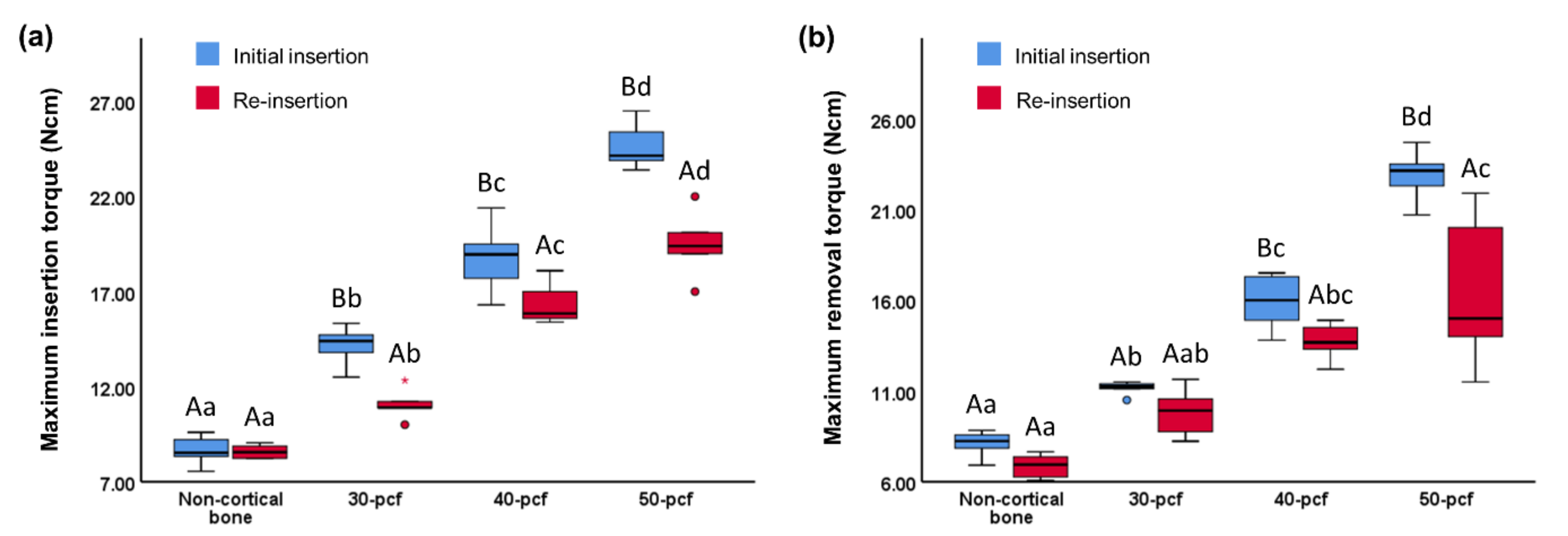
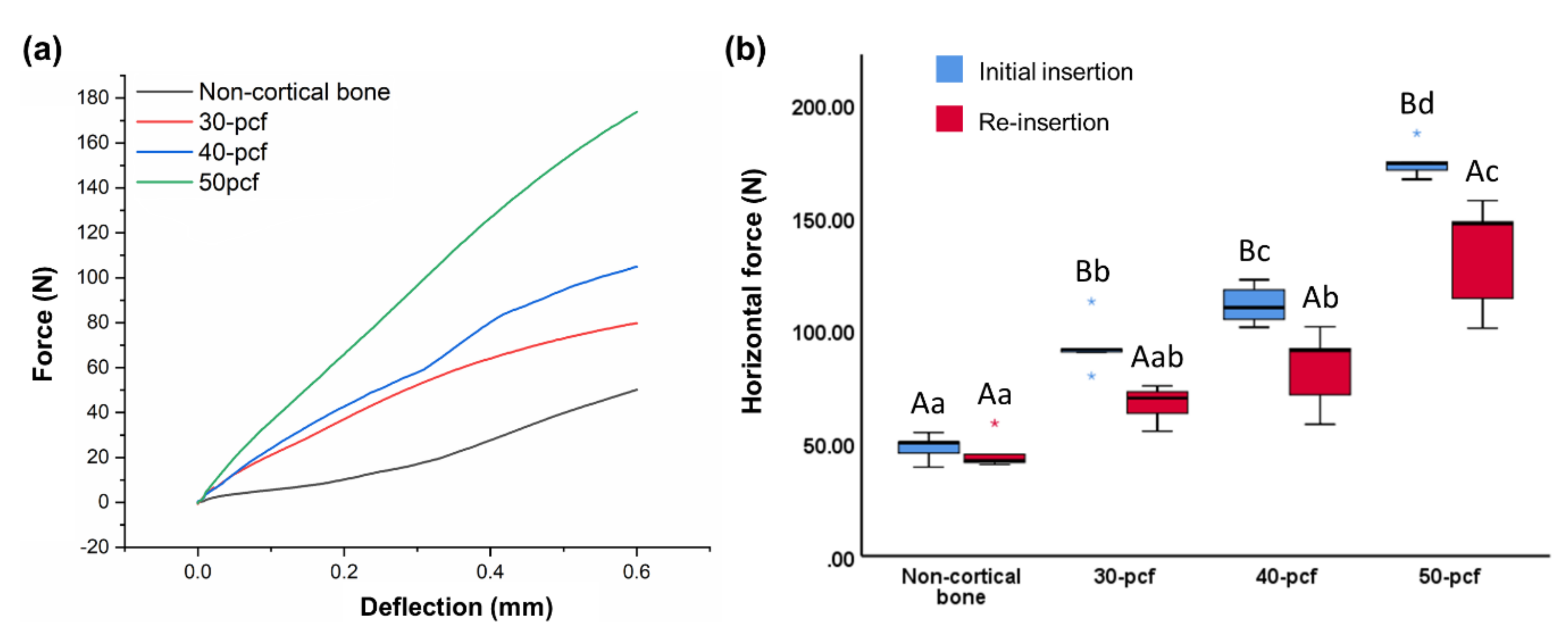
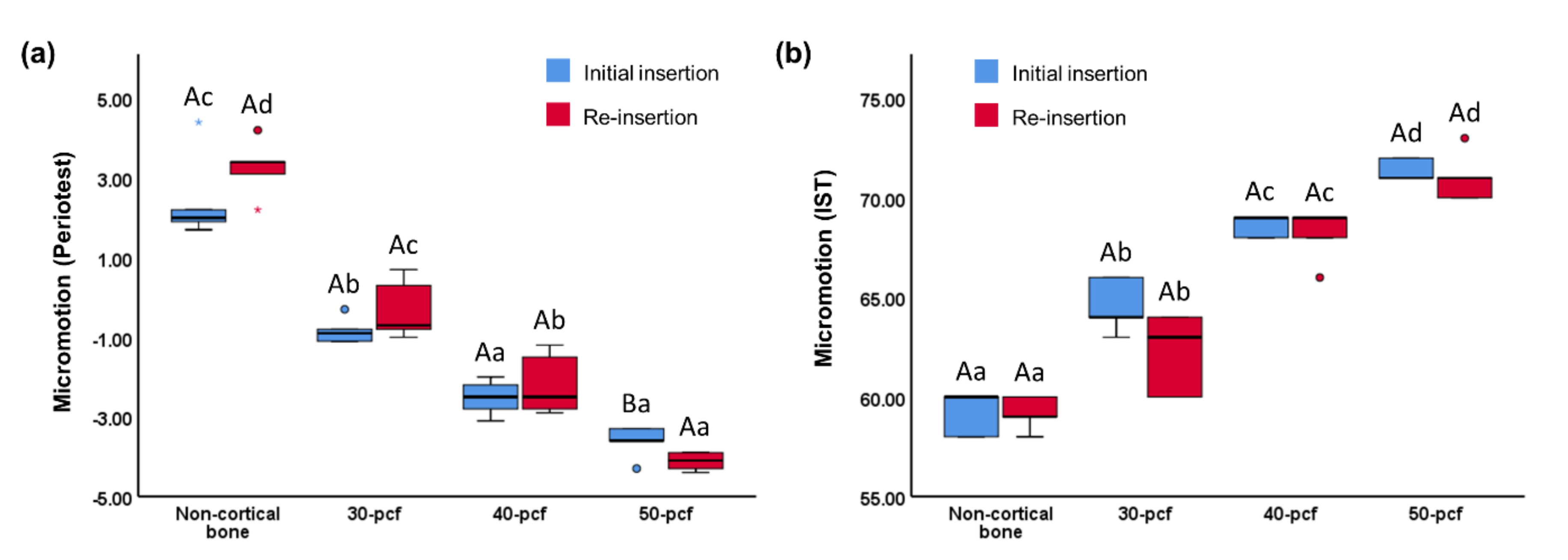
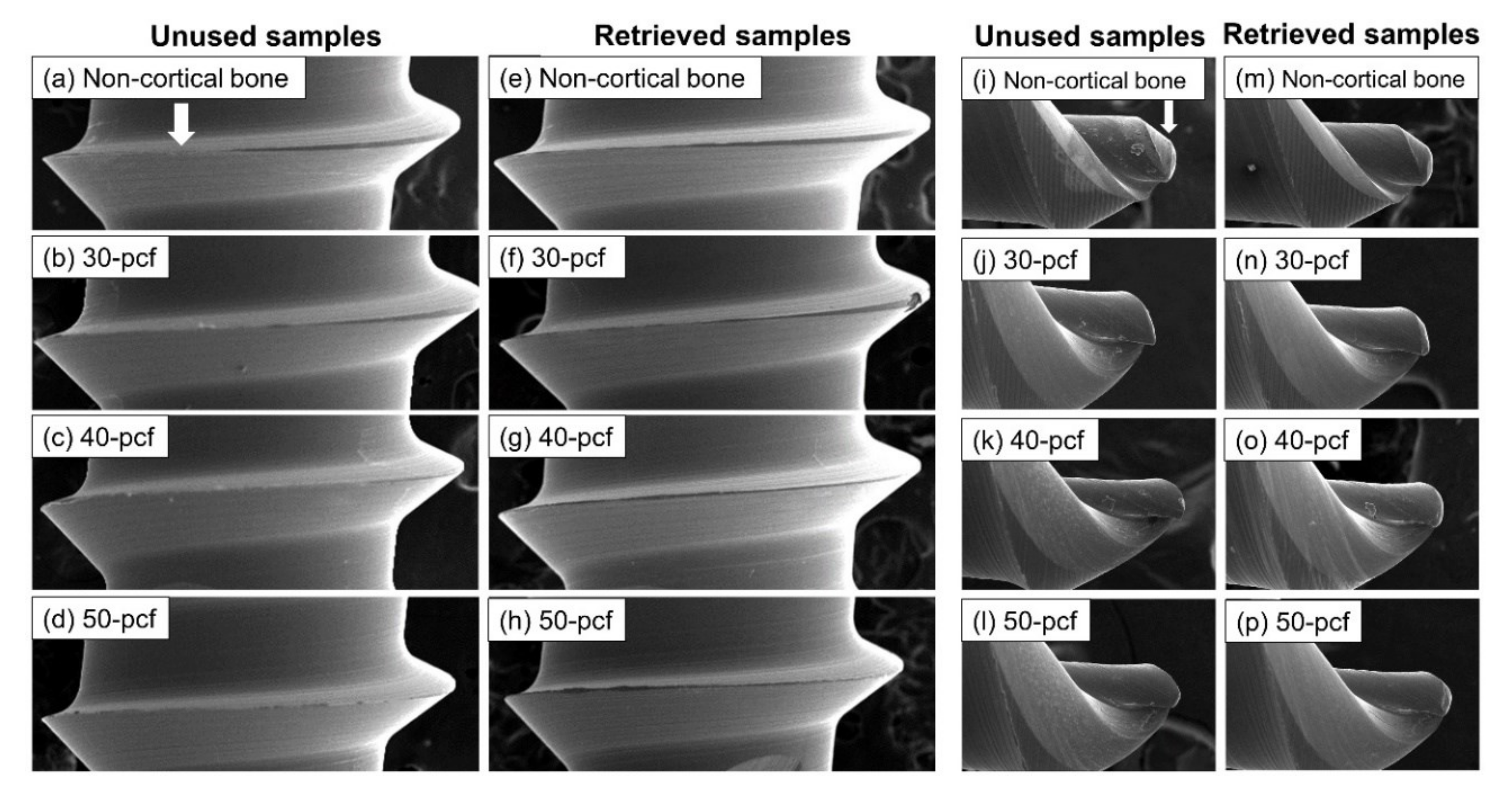
| Density | Compression | Tension | |||
|---|---|---|---|---|---|
| pcf | (g/cc) | Strength (MPa) | Modulus (MPa) | Strength (MPa) | Modulus (MPa) |
| 20 | 0.32 | 8.4 | 210 | 5.6 | 284 |
| 30 | 0.48 | 18 | 445 | 12 | 592 |
| 40 | 0.64 | 31 | 759 | 19 | 1000 |
| 50 | 0.80 | 48 | 1148 | 27 | 1469 |
| Non-Cortical Bone Mean/SD | 30 pcf Mean/SD | 40 pcf Mean/SD | 50 pcf Mean/SD | |
|---|---|---|---|---|
| MIT (Ncm) | 0.34 ± 0.45 a | 3.14 ± 0.93 b | 2.91 ± 0.80 b | 5.12 ± 0.79 c |
| MRT (Ncm) | 1.18 ± 0.66 a | 1.33 ± 1.58 a | 2.40 ± 0.86 a | 6.36 ± 3.28 b |
| Horizontal Resistance (N) | 2.47 ± 6.51 a | 25.91 ± 9.69 ab | 28.48 ± 17.19 ab | 41.10 ± 23.41 b |
| PTV | −0.82 ± 1.21 a | −0.54 ± 0.86 a | −0.34 ± 1.09 a | 0.5 ± 0.55 a |
| IST | 0 ± 1.22 a | 2.4 ± 2.30 a | ± 1.67 a | 0.4 ± 1.34 a |
© 2020 by the authors. Licensee MDPI, Basel, Switzerland. This article is an open access article distributed under the terms and conditions of the Creative Commons Attribution (CC BY) license (http://creativecommons.org/licenses/by/4.0/).
Share and Cite
Kim, G.-T.; Jin, J.; Mangal, U.; Lee, K.-J.; Kim, K.-M.; Choi, S.-H.; Kwon, J.-S. Primary Stability of Orthodontic Titanium Miniscrews due to Cortical Bone Density and Re-Insertion. Materials 2020, 13, 4433. https://doi.org/10.3390/ma13194433
Kim G-T, Jin J, Mangal U, Lee K-J, Kim K-M, Choi S-H, Kwon J-S. Primary Stability of Orthodontic Titanium Miniscrews due to Cortical Bone Density and Re-Insertion. Materials. 2020; 13(19):4433. https://doi.org/10.3390/ma13194433
Chicago/Turabian StyleKim, Gi-Tae, Jie Jin, Utkarsh Mangal, Kee-Joon Lee, Kwang-Mahn Kim, Sung-Hwan Choi, and Jae-Sung Kwon. 2020. "Primary Stability of Orthodontic Titanium Miniscrews due to Cortical Bone Density and Re-Insertion" Materials 13, no. 19: 4433. https://doi.org/10.3390/ma13194433
APA StyleKim, G.-T., Jin, J., Mangal, U., Lee, K.-J., Kim, K.-M., Choi, S.-H., & Kwon, J.-S. (2020). Primary Stability of Orthodontic Titanium Miniscrews due to Cortical Bone Density and Re-Insertion. Materials, 13(19), 4433. https://doi.org/10.3390/ma13194433







